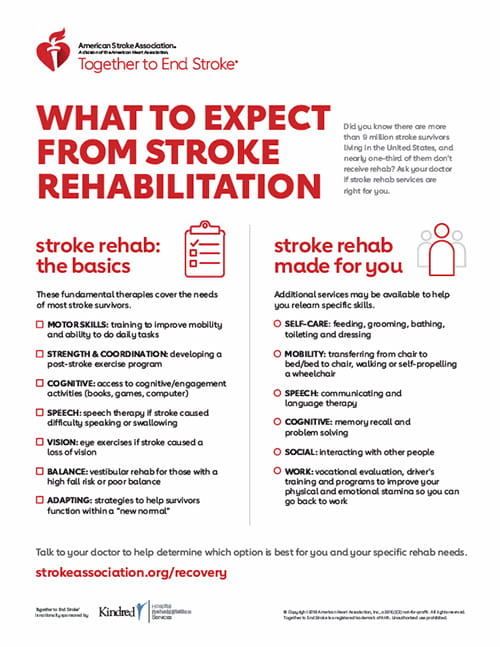What to Expect from Stroke Rehabilitation

Text Version of What to Expect from Stroke Rehabilitation
American Stroke Association a division of the American Heart Association.
Together to End Stroke What to Expect From Stroke Rehabilitation
Did you know there are more than 9 million stroke survivors living in the United States, and nearly one-third of them don’t receive rehab?
Ask your doctor if stroke rehab services are right for you.
Stroke rehab: the basics
These fundamental therapies cover the needs of most stroke survivors.
- Motor Skills: training to improve mobility and ability to do daily tasks
- Strength and Coordination: developing a post-stroke exercise program
- Cognitive: access to cognitive/engagement activities [books, games, computer]
- Speech: speech therapy if stroke caused difficulty speaking or swallowing Vision: eye exercises if stroke caused a loss of vision
- Balance: vestibular rehab for those with a high fall risk or poor balance
- Adapting: strategies to help survivors function within a “new normal”
Stroke rehab made for you
Additional services may be available to help you relearn specific skills.
- Self-Care: feeding, grooming, bathing, toileting and dressing
- Mobility: transferring from chair to bed/bed to chair, walking or self-propelling a wheelchair
- Speech ; communicating and language therapy
- Cognitive: memory recall and problem solving
- Social: interacting with other people
- Work: vocational evaluation, driver’s training and programs to improve your physical and emotional stamina so you can go back to work
- Talk to your doctor to help determine which option is best for you and your specific rehab needs.
Stroke Rehab Settings Stroke Rehabilitation: Where to get it
Considering stroke rehabilitation?
Know your options. There are many different setting for stroke rehab programs.
Talk to your doctor to help determine which option is best for you and your specific rehab needs.
- Inpatient Rehabilitation Facilities [IRF]: May be part of a hospital or free-standing facility providing services for stroke survivors who need intensive rehabilitation [at least three hour a day/five days a week]. AHA/ASA guidelines recommend IRF care for those who can literate intensive rehab.
- Skilled Nursing Facilities [SNF]: Available for stroke survivors who are not well enough to be discharged directly home and cannot tolerate the more intensive therapy provided by and IRF.
- Long-term Care Facilities: Provide long-term basic nursing care and assistance for people who need help with everyday activities, such as dressing or bathing.
- Long-term Acute Care Hospitals: For those with complex medical needs [such as those on a ventilator] due to a combination of acute and chronic conditions.
- Home or Outpatient Stroke Rehabilitation: Can be provided by home healthcare agencies or through outpatient offices.
American Stroke Association a division of the American Heart Association. Together to End Stroke
Stroke.org/recovery Together to end Stroke is nationally sponsored by Kindred Hospital Rehabilitation Services